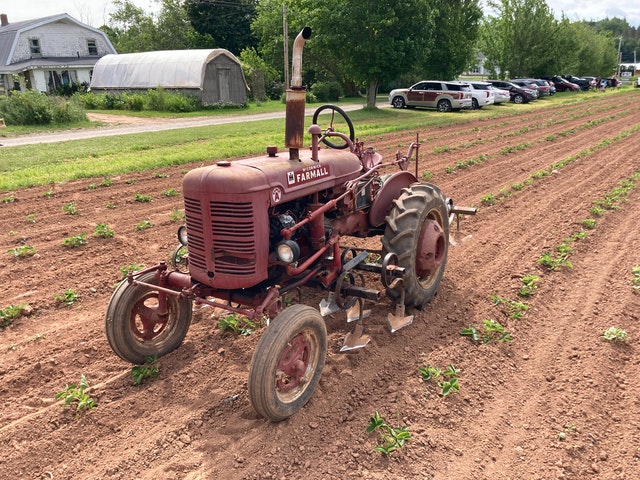
Ladakh forms a part of the cold desert that comes under the trans-Himalayan zone. It is an arid region devoid of vegetation and is not benefit by the southeast monsoon as it lies in the rain shadow area of the Himalayan mountain system. A cold desert ecosystem refers to an area where the climate has characteristics of great extremes of being hot (+35° in summers) and cold (-40° in winters) with excessive dryness. The soil of the Ladakh region is mainly alkaline and is characterized by low fertility status coupled with poor water retention capacity and scanty plant cover.
Different agroforestry systems of Ladakh
These systems are traditional ones and are not managed scientifically without any proper spacing between the trees. The trees are mainly present on the bunds of the field. The following agroforestry systems are found (mainly in the sham region of Khalatse block) in Ladakh.
1. Agri-Silviculture system: It is a type of agroforestry system in which agriculture crops are grown in combination with silviculture trees.
Agriculture crops: tro/wheat (Triticum aestivum), knas/barley (Hordeum vulgare), dro/buckwheat (Fagopyrum esculentum), chah/foxtail millet (Setaria italica), etc.
Silviculture trees: yulad/poplar (Populus nigra), malchang/willow (Salix alba), etc.
2. Agri-Horti-Silviculture system: This type of agroforestry system consists of agriculture crops grown in close association with different fruit trees and silviculture trees.
Agriculture crops: matar/pea (Pisum sativa), nyungma/turnip (Brassica rapa), rajma/red bean (Phaseolus vulgaris), bandh gobi/cabbage (Brassica oleraceae var. Botrytis), phool gobi/cauliflower (Brassica oleracea var. Capitata), etc.
Horticulture trees: chuli/apricot (Prunus armeniaca), kushu/apple (Prunus domestica), etc.
Silviculture trees: yulad/poplar (Populus nigra), malchang/willow (Salix alba), etc.
3. Silvipasture system: A type of agroforestry system in which grasses are grown along with fodder trees to fulfill the fodder requirements of farmers for their livestock.
Grasses: alfalfa/aul (Medicago sativa and Medicago falcata), tesma/iris (Iris lactea).
Fodder trees: yulad/poplar (Populus nigra), malchang/salix ( Salix alba) etc.
4. Horti-Silvi-Pasture system: In this type of agroforestry system, grasses are grown with fruit trees and silviculture trees on the same unit of land.
Fruit trees: chuli/apricot (Prunus armeniaca), kushu/apple (Prunus domestica), osay/mulberry (Morus alba), and starga/walnut (Juglans regia).
Silviculture trees: yulad/poplar (Populus nigra), malchang/willow (Salix alba), etc.
Grasses: alfalfa/aul (Medicago sativa and Medicago falcata), tesma/iris (Iris lactea).
Benefits of agroforestry system
• An agroforestry system helps in the enrichment of the soil. The addition of organic matter (in the form of leaf litter, twigs, and fruits) enhances soil’s physical, chemical, and biological properties. Nitrogen-fixing crops such as pea help in fixing atmospheric nitrogen into the soil. Therefore an agroforestry system increases the fertility of the soil.
• It is a land-use system that is sustainable and provides diversified products such as food (cereals, vegetables, fruits, etc.,), fodder for livestock (alfalfa, leaves, and twigs of poplar and salix tree), timber (poplar and salix), and fuel-wood (trees of apricot, mulberry, salix, and walnut, etc.,) from the single unit of land.
• The system provides extra income to the farmer by selling different products at different times. It also insures against total crop failure (as the case may be in a mono-cropping system). In case of failure of one component of the system, the farmer may get the return from other components of the system.
• Agroforestry improves the quality of air and underground water. Agroforestry practices such as windbreaks and shelterbelts (plantation of rows of trees) also provide protection to crops and property and reduce wind velocity and limit wind erosion. It reduces the amount of particulate matter in the air and helps in the reduction of noise pollution as well. The deep tap-root system of trees can improve groundwater quality by serving as a “safety net” and the excess nutrient that has been leached below the rooting zone of agriculture crops can be taken up by the tree roots.
Conclusion
The people of Ladakh were mainly dependent on the produces from agriculture for their sustenance for a long time. However, in recent years, the significance of the land-based economy has reduced greatly in this region because of an increasing shift in employment opportunities (e.g. tourism) other than land-based occupations. With the severity of problems such as food security and climate change that the world is facing today, agroforestry can be a solution. In terms of economic well-being, agroforestry can increase and diversify farmers’ income and allow them to have access to more nutritious food. From an environmental point of view, it helps to reduce vulnerability to climate change by sequestration of carbon dioxide (by trees and crops) which is the main factor contributing to global warming. Therefore, it is high time to encourage the farmers to practice agroforestry through different government schemes and there is a need to develop the agroforestry systems scientifically sound as the various systems mentioned above are not properly managed and maintained because of lack of knowledge and exposure.


